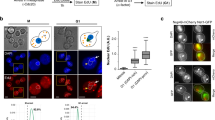Abstract
WHILE studying the behaviour of parasynchronously dividing HeLa cells (Gey), Newton and Wildy1 have measured the amount of deoxyribonucleic acid as a function of the time-interval between one division and the next. Their results suggest that the synthesis of deoxyribonucleic acid occurs during two periods in interphase: one soon after and one just before cell division. Between these periods, in mid interphase, there exists an interval during which the amount of deoxyribonucleic acid (DNA) in the cell remains approximately constant (Fig. 1, curve a).
This is a preview of subscription content, access via your institution
Access options
Subscribe to this journal
Receive 51 print issues and online access
$199.00 per year
only $3.90 per issue
Buy this article
- Purchase on Springer Link
- Instant access to full article PDF
Prices may be subject to local taxes which are calculated during checkout
Similar content being viewed by others
References
Newton, A. A., and Wildy, P., Exp. Cell Res., 16, 624 (1959).
Patau, K., Chromosoma, 5, 341 (1952).
Ornstein, L., Lab. Invest., 1, 250 (1952).
Mendelsohn, M. L., Ph.D. thesis, Cambridge University (1957).
Walker, P. M. B., J. Exp. Biol., 31, 9 (1954).
Walker, P. M. B., and Yates, Helen B., Proc. Roy. Soc., B, 40, 274 (1952).
Painter, R. B., and Drew, R. M., Lab. Invest., 8, 278 (1959).
Author information
Authors and Affiliations
Rights and permissions
About this article
Cite this article
SMITH, C., NEWTON, A. & WILDY, P. Deoxyribonucleic Acid Formation in Multiplying HeLa Cells. Nature 184, 107–108 (1959). https://doi.org/10.1038/184107a0
Issue Date:
DOI: https://doi.org/10.1038/184107a0
This article is cited by
Comments
By submitting a comment you agree to abide by our Terms and Community Guidelines. If you find something abusive or that does not comply with our terms or guidelines please flag it as inappropriate.



